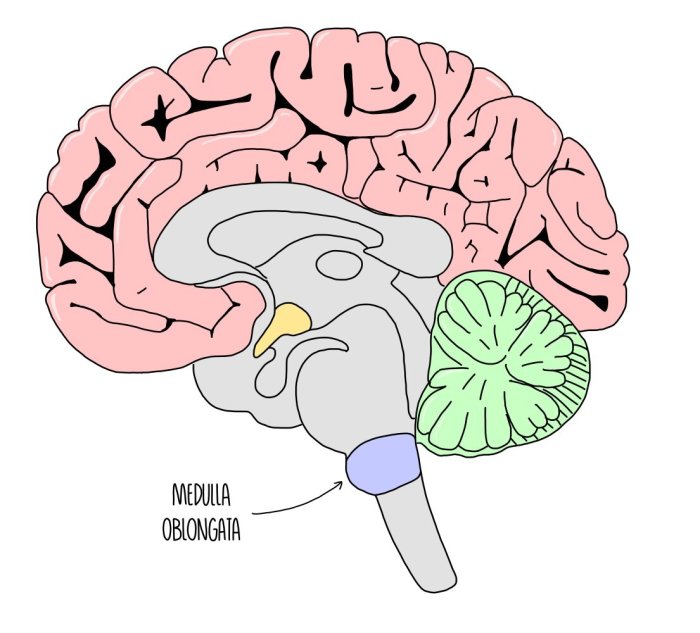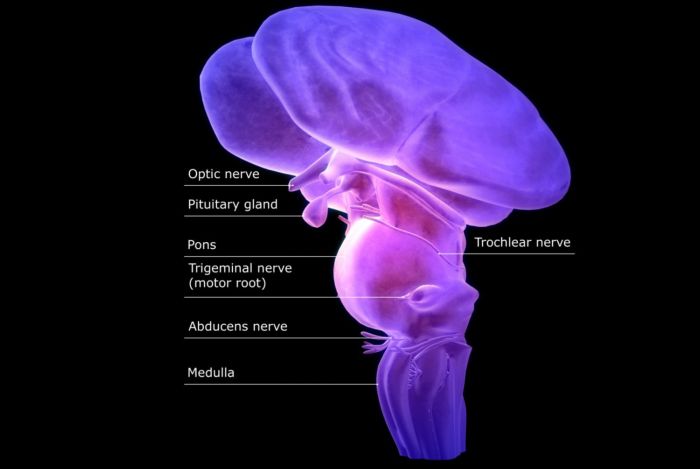What is the medulla oblongata? This vital brain stem structure sits at the base of your brain, acting as a control center for essential bodily functions. It’s intricately connected to surrounding brain regions and plays a crucial role in everything from breathing and heart rate to swallowing and sensory processing. Understanding this complex structure unlocks a deeper appreciation for the intricate workings of the human body.
The medulla oblongata’s location and role within the brain stem are crucial. It bridges the spinal cord with higher brain centers, processing and relaying signals for a vast array of functions. From regulating breathing to coordinating reflexes like coughing and vomiting, its significance is undeniable. This in-depth look delves into the anatomical details, key functions, clinical implications, and its role in maintaining homeostasis.
Introduction to the Medulla Oblongata
The medulla oblongata, a crucial component of the brainstem, sits at the very bottom of the brain, connecting the brainstem to the spinal cord. This vital structure plays a pivotal role in controlling fundamental life-sustaining functions, acting as a vital relay station for information between the brain and the body. Its location and intricate network of nerves make it a critical hub for regulating breathing, heart rate, and other essential processes.The medulla oblongata is situated immediately superior to the spinal cord, forming a crucial link between the higher brain centers and the rest of the body.
Surrounding structures, such as the pons and midbrain, contribute to the complex interplay of neural signals that pass through the medulla. This strategic position underscores its significance in maintaining homeostasis and coordinating bodily functions. Its close proximity to the spinal cord facilitates rapid communication and control over reflexes and autonomic processes.
Anatomical Relationships
The medulla oblongata is nestled within the brainstem, positioned immediately above the spinal cord. It’s connected to the pons, a structure above it, and the midbrain, located further up. These interconnected structures form a vital pathway for information traveling between the brain and the body. The cerebellum, positioned behind the pons and medulla, also interacts with the medulla through neural connections.
This complex arrangement of structures ensures coordinated control over various bodily functions.
Key Regions and Structures
Understanding the medulla oblongata’s internal organization is critical to appreciating its function. The medulla is composed of various nuclei, each with specialized roles.
| Region/Structure | Function |
|---|---|
| Cardiovascular Center | Regulates heart rate and blood pressure. |
| Respiratory Center | Controls breathing rate and rhythm. |
| Reflex Centers | Coordinates reflexes such as coughing, sneezing, swallowing, and vomiting. |
| Sensory and Motor Nuclei | Relay sensory information from the body to the brain and motor commands from the brain to the body. |
| Nuclei for Cranial Nerves | Contain nuclei for several cranial nerves, crucial for sensory and motor functions of the head and neck. |
These various centers and nuclei, working together, allow the medulla oblongata to manage crucial life-sustaining processes. The interplay between these regions ensures the body’s smooth and coordinated operation.
Structures within the Medulla Oblongata

The medulla oblongata, a vital part of the brainstem, is a crucial nexus for numerous bodily functions. Its intricate structure houses vital centers that regulate breathing, heart rate, and blood pressure, all essential for life. Understanding the nuclei, tracts, and reticular formation within the medulla provides insight into its multifaceted role in maintaining homeostasis.The medulla oblongata is packed with vital nuclei and tracts that govern essential life functions.
These structures act as communication hubs, relaying information between the brain and the rest of the body. A thorough understanding of these structures reveals the complexity and sophistication of the human nervous system.
Key Nuclei and Their Functions
The medulla oblongata contains numerous nuclei, each specialized for particular functions. These nuclei are clustered groups of nerve cell bodies. These nuclei play a critical role in relaying signals between the brain and the body, ensuring smooth functioning of vital systems.
- Cardiovascular centers: These nuclei regulate heart rate and blood pressure. They adjust the force and frequency of heart contractions in response to changing demands of the body, ensuring consistent blood flow.
- Respiratory centers: These nuclei control the rate and rhythm of breathing. They adjust breathing based on factors like blood gas levels and levels of carbon dioxide in the blood, ensuring adequate oxygen intake and carbon dioxide removal.
- Reflex centers: The medulla houses various reflex centers responsible for involuntary actions like coughing, sneezing, swallowing, and vomiting. These automatic responses are crucial for maintaining overall bodily integrity.
- Sensory and motor nuclei: These nuclei relay sensory information from the body to the brain and transmit motor commands from the brain to the body. They ensure that the brain receives information about the body’s status and sends instructions for its proper functioning.
The Reticular Formation, What is the medulla oblongata
The reticular formation is a diffuse network of interconnected neurons extending throughout the brainstem. Its significance lies in its role in regulating consciousness and alertness.
The reticular formation plays a crucial role in maintaining arousal and wakefulness. It filters sensory input and sends signals to higher brain centers, influencing alertness and sleep-wake cycles. Damage to this network can result in altered states of consciousness, ranging from drowsiness to coma.
Tracts Passing Through the Medulla Oblongata
Numerous ascending and descending tracts traverse the medulla oblongata, carrying sensory and motor information. These tracts facilitate communication between different levels of the nervous system.
The medulla oblongata, a crucial part of the brainstem, plays a vital role in regulating essential bodily functions like breathing. Understanding its role helps us appreciate how important proper breathing is to overall health. If you’re wondering if you can manage wheezing without medication, checking out this article on can i stop wheezing without an inhaler might offer some helpful insights.
Ultimately, though, proper medical advice is key when dealing with breathing difficulties, and understanding the medulla oblongata is part of that overall picture.
- Ascending tracts: These tracts carry sensory information from the body to the brain. They relay details about touch, temperature, pain, and proprioception (body position).
- Descending tracts: These tracts carry motor commands from the brain to the body. They initiate voluntary movements and control reflexes.
Nuclei and Bodily Functions
| Nucleus | Bodily Function |
|---|---|
| Cardiovascular centers | Regulate heart rate and blood pressure |
| Respiratory centers | Control breathing rate and rhythm |
| Reflex centers | Coordinate reflexes like coughing, sneezing, swallowing, and vomiting |
| Sensory and motor nuclei | Relay sensory information and motor commands |
Sensory Processing and Motor Control
The medulla oblongata acts as a critical relay station for both sensory and motor information. Sensory information from the body is relayed to the brain, while motor commands from the brain are transmitted to the body. This process is crucial for maintaining homeostasis and ensuring coordinated bodily functions.
The medulla oblongata is a crucial part of the brainstem, responsible for vital functions like breathing and heart rate. Understanding its role in these fundamental processes is key, and it’s often affected by conditions like Multiple Sclerosis. Navigating daily life with MS can be challenging, and choosing the right assistive device, like a cane for multiple sclerosis , can make a real difference in maintaining independence.
Ultimately, the medulla oblongata’s complex role in the body underscores the importance of supporting those with neurological conditions.
Medulla Oblongata and Homeostasis
The medulla oblongata, a vital brainstem structure, acts as a crucial control center for maintaining homeostasis, the body’s internal equilibrium. It constantly monitors and adjusts various physiological parameters to ensure survival. This intricate regulatory function is fundamental to life, as deviations from optimal conditions can lead to serious health consequences.The medulla oblongata achieves this homeostasis through complex feedback loops involving sensory input, integration, and effector responses.
It receives signals from various parts of the body, processes the information, and then initiates actions to restore balance. This sophisticated system ensures that vital functions like body temperature, blood pressure, and blood pH are maintained within the narrow ranges necessary for optimal bodily function.
Regulation of Body Temperature
The medulla oblongata plays a central role in thermoregulation. It houses the thermoregulatory center, which constantly monitors the body’s core temperature. This center receives input from temperature receptors located throughout the body. When body temperature deviates from the set point, the medulla oblongata initiates appropriate responses. For instance, if the body overheats, the medulla triggers sweating to dissipate heat.
The medulla oblongata is a crucial part of the brainstem, controlling vital functions like breathing and heart rate. Sometimes, adults experience communication challenges like selective mutism, a condition where someone avoids speaking in certain social situations. Understanding the complexities of such conditions like selective mutism in adults can help us appreciate the intricate interplay between the brain and behavior, and how even seemingly simple actions, like speaking, are heavily reliant on the proper functioning of the medulla oblongata and other brain regions.
It’s a fascinating area of study!
Conversely, if the body becomes too cold, the medulla initiates shivering to generate heat. This intricate feedback loop maintains a stable body temperature.
Regulation of Blood pH
Maintaining the proper blood pH is another critical aspect of homeostasis, and the medulla oblongata is directly involved in this process. The medulla oblongata receives input from chemoreceptors that detect changes in blood pH. If the blood becomes too acidic, the medulla oblongata signals the respiratory system to increase the rate and depth of breathing. This increased ventilation expels carbon dioxide, which helps to restore the blood pH to normal levels.
Conversely, if the blood becomes too alkaline, the medulla oblongata regulates breathing to reduce the rate and depth of ventilation. This sophisticated regulatory system ensures the blood pH remains within a narrow, life-sustaining range.
Regulation of Blood Pressure
The medulla oblongata’s role in blood pressure regulation is essential. Baroreceptors located in the major blood vessels monitor blood pressure. If blood pressure rises above the set point, the medulla oblongata signals the cardiovascular system to reduce the heart rate and the constriction of blood vessels. Conversely, if blood pressure drops below the set point, the medulla oblongata stimulates the heart to beat faster and blood vessels to constrict.
This ensures the maintenance of adequate blood pressure for proper organ perfusion.
Feedback Loops and Homeostatic Effects
| Feedback Loop | Effect on Homeostasis |
|---|---|
| Thermoregulation | Maintains body temperature within a narrow range. |
| Blood pH Regulation | Maintains blood pH within a narrow range, crucial for enzyme function. |
| Blood Pressure Regulation | Maintains adequate blood pressure for organ perfusion. |
Comparison with Other Brain Structures: What Is The Medulla Oblongata

The medulla oblongata, a crucial component of the brainstem, orchestrates vital autonomic functions. Understanding its role requires comparing it to other brainstem structures, particularly the pons and midbrain, to highlight its unique contributions. These structures, while interconnected, possess distinct functionalities that contribute to the overall complexity of the central nervous system.The brainstem, including the medulla oblongata, pons, and midbrain, forms a vital connection between the spinal cord and higher brain centers.
While all three play critical roles in regulating essential bodily functions, their specific contributions differ. The medulla oblongata, situated at the base of the brainstem, primarily manages involuntary processes. The pons and midbrain, positioned above the medulla, play a more significant role in sensory and motor functions, as well as higher-level cognitive processes. This comparative analysis reveals the hierarchical organization of the brainstem and its integration with other brain regions.
Functions of the Brainstem Structures
The medulla oblongata, pons, and midbrain are interconnected, working together to regulate various bodily functions. However, each structure possesses distinct functions. The medulla’s primary role lies in regulating autonomic functions, including respiration, heart rate, and blood pressure. The pons acts as a bridge between the cerebellum and other parts of the brain, influencing sleep, respiration, and swallowing.
The midbrain, the most superior brainstem structure, plays a vital role in processing sensory information, controlling eye movements, and regulating auditory and visual reflexes.
Unique Contributions of the Medulla Oblongata
The medulla oblongata’s unique contribution stems from its direct control over vital autonomic functions. It contains crucial centers responsible for regulating breathing, heart rate, and blood pressure. Damage to these centers can lead to severe consequences, potentially resulting in respiratory arrest, cardiac failure, or death. The medulla’s intricate network of neurons allows for precise control over these essential processes, ensuring their coordination with other brain regions.
This direct control differentiates it from other brainstem structures.
Comparison Table
| Structure | Primary Functions | Higher-Level Functions |
|---|---|---|
| Medulla Oblongata | Breathing, heart rate, blood pressure, swallowing, vomiting | Reflexes, basic autonomic functions |
| Pons | Bridge between cerebellum and other parts of the brain, sleep, respiration, swallowing | Sleep-wake cycles, sensory information relay |
| Midbrain | Sensory processing, eye movements, auditory and visual reflexes | Higher-level motor control, some cognitive functions |
Interaction with Other Brain Regions
The medulla oblongata interacts with various brain regions to regulate complex behaviors. For instance, the hypothalamus, a brain region involved in homeostasis, sends signals to the medulla to adjust heart rate and blood pressure in response to changing internal conditions. The cerebral cortex, responsible for higher-level cognitive functions, can also influence the medulla through descending pathways, modulating autonomic responses.
These interactions ensure that the medulla’s autonomic functions are coordinated with other brain regions to maintain overall homeostasis.
Graphic Depicting Interactions
Imagine a complex network of interconnected nodes. The medulla oblongata, centrally located, is depicted as a hub receiving and sending signals to various other brain regions. The hypothalamus, a nearby node, sends regulatory signals related to homeostasis, while the cerebral cortex, located more peripherally, sends modulating signals affecting the medulla’s autonomic functions. This graphic illustrates the multifaceted interactions of the medulla with other brain regions to orchestrate complex behaviors. The connections depict the pathways and interactions that ensure the smooth and coordinated functioning of the body.
Advanced Considerations
The medulla oblongata, a vital brainstem structure, orchestrates numerous fundamental bodily functions. Beyond its role in autonomic processes, the medulla plays a surprisingly intricate part in higher-level functions, including sleep-wake cycles and emotional responses. Understanding these intricate connections is crucial for comprehending the complexity of the human nervous system and for developing potential treatments for neurological disorders.The medulla oblongata’s intricate network of neurons and neurotransmitters allows for a fine-tuned regulation of vital functions.
This sophisticated control extends beyond basic reflexes to more complex processes like emotional responses and sleep-wake cycles, making the medulla a crucial hub in the brain’s communication network. Exploring its advanced functions opens new avenues for understanding neurological health and disease.
Sleep-Wake Cycles and Neurotransmitters
The medulla oblongata is a key player in the sleep-wake cycle, regulating transitions between these states. Specific neurotransmitter systems within the medulla influence the timing and quality of sleep. For example, the release of norepinephrine is linked to arousal, while the production of serotonin and GABA contributes to sleep onset and maintenance. The balance of these neurotransmitters is crucial for maintaining a healthy sleep-wake cycle.
Role in Emotional Responses
The medulla oblongata, while not the primary center for emotion, plays a role in emotional responses by influencing autonomic responses. Emotional states can trigger changes in heart rate, breathing, and other physiological parameters. The medulla’s role in regulating these autonomic responses provides a connection between emotional stimuli and physical reactions. These connections are not fully understood, but research suggests a subtle yet significant interplay between emotional processing and the medulla’s autonomic functions.
Future Research Directions
Future research into the medulla oblongata should focus on developing more sophisticated methods for visualizing and understanding its intricate neural circuits. Advances in neuroimaging techniques, such as functional magnetic resonance imaging (fMRI) and diffusion tensor imaging (DTI), offer potential for studying the medulla’s role in complex behaviors. Researchers could investigate how these structures interact during specific emotional or cognitive tasks.
Furthermore, understanding the precise mechanisms underlying the medulla’s influence on sleep-wake cycles, particularly in relation to sleep disorders, remains a crucial area for exploration.
Neuroimaging Techniques and the Medulla
Advancements in neuroimaging, such as fMRI and DTI, provide powerful tools for studying the medulla oblongata. fMRI allows researchers to observe activity within the medulla in real-time, while DTI can visualize the structural connections within and around this critical region. These techniques, combined with electrophysiological recordings, can provide a more complete picture of the medulla’s intricate functions. Using these technologies to monitor changes in the medulla during different states of consciousness, such as sleep and wakefulness, can offer valuable insights into the underlying neural mechanisms.
Neurotransmitters and Medulla Functions
| Neurotransmitter | Specific Functions in the Medulla |
|---|---|
| Norepinephrine | Plays a crucial role in arousal and alertness. |
| Serotonin | Contributes to sleep onset and maintenance, influencing mood regulation. |
| GABA | Inhibits neuronal activity, promoting relaxation and sleep. |
| Acetylcholine | Influences autonomic functions, including heart rate and respiration. |
| Dopamine | Potentially involved in certain motor functions and reward-related processes within the medulla. |
This table highlights the relationship between key neurotransmitters and their potential roles in various medulla functions. It is important to note that these are not exhaustive and ongoing research continues to uncover more intricate connections. For example, the interaction of multiple neurotransmitters is crucial in regulating the medulla’s diverse activities.
Closure
In conclusion, the medulla oblongata is a fundamental component of the human nervous system, orchestrating essential bodily functions. Its intricate structure and vital roles in autonomic control, sensory processing, and homeostasis underscore its significance in maintaining life. Understanding the medulla oblongata not only enhances our knowledge of the brain but also highlights the interconnectedness of all bodily systems.
Further research and exploration into its complexities continue to shed light on the intricate ways our bodies operate.




